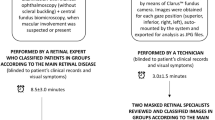Abstract
Objective: To study the effectiveness of two digital 50° photographic fields per eye, stored compressed or integrally, in the grading of diabetic retinopathy, in comparison to 35-mm colour slides. Subjects and methods: Two-field digital non-stereoscopic retinal photographs and two-field 35-mm retinal photographs were made at the same time from patients visiting a diabetic retinopathy outpatient clinic. The digital images were stored integrally (TIFF-file) and in a compressed way (JPEG-file). Two ophthalmologists assessed the photographs in a masked fashion. The results were compared. The sensitivity and specificity for the detection of vision-threatening diabetic retinopathy were calculated, using only the grading of the most affected eye. The differences between the retinopathy gradings of the two kinds of photographs were analysed. Results: The agreement for the grading of DR compared to slides was good, both for the compressed and for the integrally stored images (kappa 0.63–0.68). The sensitivity for the detection of vision-threatening diabetic retinopathy using the JPEG-stored images was 0.72–0.74, specificity 0.93–0.98. The sensitivity for vision-threatening retinopathy detection using the integrally stored images was 0.86–0.92, specificity 0.93. Conclusions: Two-field digital retinal photography is effective in diabetic retinopathy grading and it can replace 35-mm retinal photography. Vision-threatening retinopathy can be detected on the images with reasonable to good sensitivity and specificity. An experienced grader should assess the images. The compression of the digital images seems to have some adverse effect on the detection of diabetic retinopathy.
Similar content being viewed by others
References
Stellingwerf C, Hardus PLLJ, Hooymans JMM. Two-eld photography can identify patients with vision-threatening diabetic retinopathy. Diabetes Care 2001; 24:2086–90.
Kerr D, Cavan DA, Jennings B, Dunnington C, Gold D, Crick M. Beyond retinal screening:digital imaging in the assessment and follow-up of patients with diabetic retinopathy. Diabet Med 1998; 15:878–882. 3._Taylor DJ, Fisher J, Jacob J, Tooke JE. The use of digi-tal cameras in a mobile retinal screening environment. Diabet Med 1999; 16:680–86.
Lim JI, LaBree L, Nichols TL, Cardenas I. A compari-son of digital nonmydriatic fundus imaging with stan-dard 35-millimeter slides for diabetic retinopathy. Ophthalmology 2000; 107:866–70.
American College of Physicians, American Diabetes Association and American Academy of Ophthalmology: Screening guidelines for diabetic retinopathy. Ann Intern Med 1992; 116;116:683–85.
British Diabetic Association. Retinal photography screening for diabetic eye disease. London:British Dia-betic Association, 1997.
Klein R, Klein BEK, Magli YL, Brothers RJ, Meuer SM, Moss SE, Davis MD. An alternative method of grading diabetic retinopathy. Ophthalmology 1986; 93:1183–87.
Bursell SE, Cavallerano JD, Cavallerano AA, Clermont AC, Birkmire-Peters, Aiello LP, Aiello LM. Stereo non-mydriatic digital-video color retinal imaging compared with early treatment diabetic retinopathy study seven standard eld 35-mm stereo color photos for determining level of diabetic retinopathy. Ophthalmology 2001; 108: 572–85.
Tennant MTS, Greve MDJ, Rudnisky CJ, Hillson TR, Hinz BJ. Identification of diabetic retinopathy by stereoscopic digital imaging via teleophthalmology:a comparison to slide lm. Can J Ophthalmol 2001; 36: 187–96.
Go´mez-Ulla F, Fernandez MI, Gonzalez F, Rey P, Rodriguez M, Rodriguez-Cid MJ, Casanueva FF, Tome MA, Garcia-Tobio J, Gude F. Digital retinal images and teleophthalmology for detecting and grading diabetic retinopathy. Diabetes Care 2002; 25:1384 –89.
Hutchinson A, McIntosh A, Peters J, O' Keefe C, Khunti K, Baker R, Booth A. Effectiveness of screening and monitoring tests for diabetic retinopathy –a systematic review. Diabet Med 2000; 17: 495–506.
Henricsson M, Karlsson C, Ekholm L, Kaikkonen P, Sellman A, Steffert E, Tyrberg M. Colour slides or digital photography in diabetes screening –a comparison. Acta Ophthalmol Scand 2000; 78:164–68.
Scanlon PH, Malhotra R, Thomas G, Foyt C, Kirkpatrick JN, Lewis-Barned N, Harney B, Aldington SJ. The effectiveness of screening for diabetic retinopathy by dig-ital imaging photography and technician ophthalmos-copy. Diabet Med 2003; 20:467–74.
Javitt JC, Canner JK, Frank RG, Steinwachs DM, Sommer A. Detecting and treating retinopathy in patients with type 1 diabetes mellitus. A health policy model. Ophthalmology 1990; 97:483–94.
Javitt JC, Aiello LP, Chiang Y, Ferris FL 3rd, Canner JK, Greenfield S. Preventive eye care in people with dia-betes is cost-saving to the federal government. Implica-tions for health-care reform. Diabetes Care 1994; 17(8): 909–17.
Lee MS, Shin DS, Berger JW. Grading, image analysis, and stereopsis of digitally compressed fundus images. Retina 2000; 20:275–81.
Newson R, Moate B, Casswell. Screening for diabetic retinopathy using digital colour photography and oral fluorescein angiography. Eye 2000; 14:579–82.
Author information
Authors and Affiliations
Rights and permissions
About this article
Cite this article
Stellingwerf, C., Hardus, P. & Hooymans, J. Assessing diabetic retinopathy using two-field digital photography and the influence of JPEG-compression. Doc Ophthalmol 108, 203–209 (2004). https://doi.org/10.1007/s10633-004-5733-2
Issue Date:
DOI: https://doi.org/10.1007/s10633-004-5733-2




